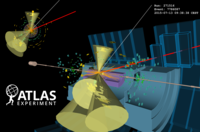Collaboration
Palacký University intensively supports the internationalization of the educational and scientific research environment, international mobility of students, academics and researchers, and pays attention to the development of international partnerships in education and creative activities. In 2019, Palacký University was engaged in 34 projects together with foreign institutions.
CERN-ATLAS collaboration
The Experimental Particle Physics group from the Joint Laboratory of Optics and the Regional Centre of Advanced Technologies and Materials at the UP Faculty of Science collaborates with the international CERN laboratory on the ATLAS experiment, aimed at basic research into the physics of the microworld. What particles is our world made from? Why do particles have mass? Why is there far more matter than antimatter in the universe? Do particles of dark matter, supersymmetric particles, and new interactions exist? Answers to these questions are sought by these scientists.
The proton-proton collisions, provided by the LHC accelerator in the heart of the ATLAS detector, lead to the creation of rare, short-lived particles which had existed shortly after the Big Bang. A thorough analysis of particle tracks after their disintegration allows an estimation of which particles were born in the high-energy collisions. For instance, in 2012 the long-sought Higgs boson was discovered in an ATLAS experiment. The members of Olomouc group focus on the physics of the heaviest known quark, “top quark”, on calibration of Hadron jets, and optical and electronic development of time detectors for the registration of protons which survived the collision.
Pierre Auger Observatory
The observatory was named after the physicist Pierre Victor Auger, the discoverer of cosmic radiation showers. It is located in the Argentine Pampas at an altitude of around 1400 metres a.s.l., and it was fully completed in 2008. It is employed for the detection of ultra-high energy cosmic radiation.
The team of scientists, including experts from the Joint Laboratory of Optics and the Regional Centre of Advanced Technologies and Materials, found an important answer to the question about the origin of cosmic rays raining down on the Earth. Their article, published in the September 2017 issue of Science, provided experimental evidence that particles with extremely high energies (millions of times higher than the ones that can be made in the largest LHC accelerator) do not originate from our galaxy. Although the work confirms the extraterrestrial origin of such particles, their precise source cannot yet be ascertained. The study merely indicates a wider section of the sky where these particles come from. Nonetheless, this finding means an advance for scientists. The group from Olomouc supplied a substantial part of the mirrors for the fluorescence telescopes in the observatory, designed its optoelectronic control system, and participates in its daily operation.
Cherenkov Telescope Array
Scientists from the Regional Centre of Advanced Technologies and Materials and the Joint Laboratory of Optics apply their expert knowledge in collaboration with the Cherenkov Telescope Array (CTA).Their goal is to provide future generations with new surface astronomical observatories to detect high-energy gamma radiation: one in the Southern hemisphere, in the Atacama desert in Chile; and one in the Northern hemisphere, on La Palma island in the Canary Islands.
The project aims to find a large number of yet-unknown cosmic sources of high-energy gamma radiation and describe their characteristics. In May 2015 a regular meeting of scientists participating in the preparations for the construction of the new CTA observatory took place in Turku, Finland, where the UP Faculty of Science was officially admitted to the consortium. Experts from the Regional Centre of Advanced Technologies and Materials and the Joint Laboratory of Optics have long collaborated in the preparation and realisation of the project by long-term monitoring of cloud cover and night-sky background light in the candidate sites for the future observatory (Namibia, Argentina, Chile, Mexico, the United States, the Canary Islands), by designing and testing the mirror segments and optical layers for optical telescopes, physical modelling and so forth. The existing achievements of the Olomouc group constituted a valid recommendation for admission of the Olomouc faculty into this prestigious consortium. The Czech Republic is now represented in this project by three institutes – the Physical Institute at the Czech Academy of Sciences, the Charles University Faculty of Mathematics and Physics in Prague, and the Palacký University Olomouc Faculty of Science.


